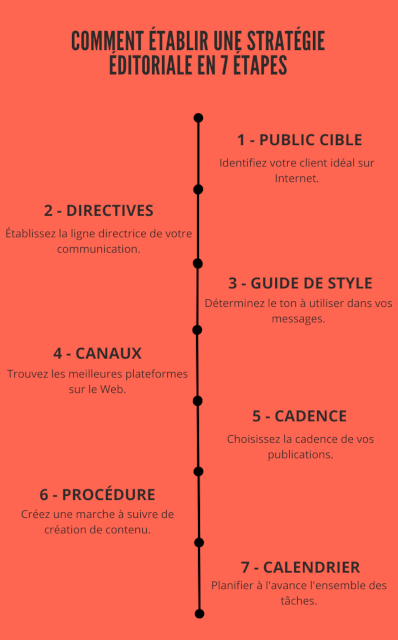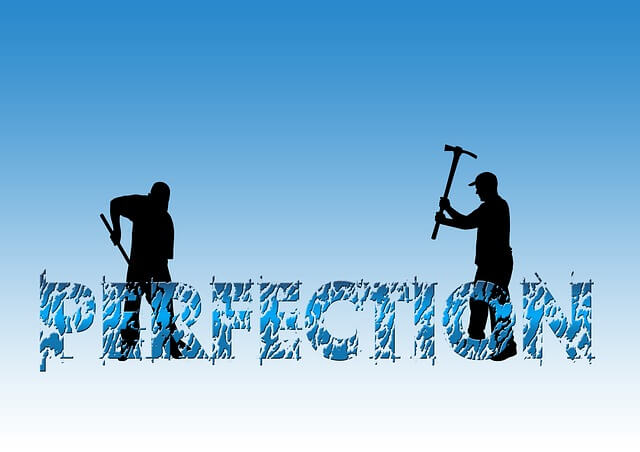To be visible on the Internet and improve your sales, you are aware that you must implement a content strategy. However, you don't know how to proceed? That's why I've chosen to detail 7 rules to follow for effective digital communication. Are you ready to learn how marketers establish an effective editorial strategy?
If so, you will discover in a moment the best way to satisfy the needs of your audience and your business. By basing yourself on the methodology proposed below, you will have the necessary skills to transform this abstract notion into concrete action.
🚀 Express Reading: 2 minutes to learn how to establish an editorial strategy
You only have a few minutes to learn how to establish an editorial strategy in 7 steps? I offer you a quick read of the essential points before you have time to come back and read the entire article.

- Identify your target audience: who is your ideal customer?
- Set up editorial guidelines: what is the guiding principle?
- Write a style guide: what tone to use?
- Choose distribution channels: which platforms to favor?
- Define a publication frequency: which frequency to choose?
- Establish a content creation process: what are the steps to follow?
- Develop an editorial calendar: when to publish?
👨💻 The fundamentals of an editorial strategy (definition, pros and cons)
If you want to know how to establish an editorial strategy that brings results, you must first know the fundamentals of this practice. That's why I quickly remind you below the essential points to know before you start.
What is the definition of an editorial strategy?
The editorial strategy is the guiding principle for the creation and publication of all your content on the Internet.
Also called content strategy, this process allows you to harmonize your communication on the Web as well as the work of your copywriters and other members of your editorial team.
What are the advantages of an editorial strategy?
I could list numerous benefits of a content strategy, but since this is not the main topic of this article, here are just the main ones.
- Harmonization: your way of communicating on the Web is consistent.
- Coherence: your points of view remain consistent in the long term.
- Identification: you are easily recognizable thanks to your communication style.
- Personalization: your message is adapted to your business and your audience.
- Visibility: you reach all distribution channels and improve your SEO.
- Performance: your revenues increase as you adjust your editorial strategy.
What are the disadvantages of an editorial strategy?
Of course, no concept is perfect! Here are some drawbacks you might face.
- Skills: the creation of your content requires skills that involve the work of several stakeholders.
- Budget: your editorial team and SEA (paid search) are costly.
- Time-consuming: the implementation of the strategy and content creation takes time.
- Consistency: once launched, your digital communication must be regular in the long term.
📜 How to establish an editorial strategy in 7 steps?
It's time to get to the heart of the matter! Now that you know exactly why you should establish an editorial strategy, here's how to do it. Note that I have put these 7 steps in a logical order that I invite you to follow.
1. Identify your target audience

You can't speak to everyone at the same time! Indeed, if you remain vague in your statements and do not address a specific audience, your message will not be heard. By acting this way, your target audience does not feel understood and remains frustrated when reading your content. For your editorial strategy to be effective, you must do the exact opposite. You want to avoid being generalist and communicate to a specific audience, your own.
A high-performance content strategy is a personalized way of communicating. For example, if you address someone by their first name, your message will be more impactful than talking about a general case. You must show empathy and demonstrate that you understand the difficulties, objectives, and challenges of your target customer. You thus give them all the information that precisely answers their questions.
To define the avatar of your typical listener, you can simply conduct surveys among your current clientele. You also have the option to analyze the use of your products or understand the specific needs related to each of your services. To identify your target, I suggest you try to answer these different questions.
- Why does your solution suit them? List your competitive advantages that correspond to the specific purchasing needs of your targets.
- What are the needs of your prospect? Find out the reasons that led your customers to trust you.
- What are the expected results? Discover the precise expectations of your audience.
- Who are your best customers? Analyze their profiles, experiences, and behaviors.
2. Set up editorial guidelines

Your goal is to provide high-quality content consistently. This point is essential to please your reader, but also for your natural referencing. That's why you set up detailed editorial guidelines.
In this document, you will group together all the essential principles for writing quality content. In addition, you detail the results of the analysis of your target audience, including their needs, desires, and typical profile.
To create quality content, here are some elements that you should absolutely include in your editorial guidelines:
- Relevance: relevant topics meet both the needs of your audience and the objectives of the company.
- Comprehensiveness: the theme addressed must be treated in its entirety to retain your traffic.
- Complementarity: to demonstrate your area of expertise, work on keyword clustering.
- Feasibility: your advice must be applicable after reading the content.
In addition, to set up this guideline and help you know how to create an editorial line, I suggest you follow these 3 steps:
- Compare: your various direct competitors to understand their different editorial strategies. Be sure to look at their websites, see if they advertise on the Internet, understand their activity on social networks, and find out if they communicate on other media.
- Search: your SEO competitors on search engines to find out how to improve your visibility. Thus, you can, among other things, know the length of their texts, the types of content they add to their articles (images, videos, etc.), and their local, national, and international visibility.
- Apply: you can now adapt your own content to what you have determined to be the most effective. Above all, do not copy what has already been done! You want to be recognizable and have your brand image represented in your publications.
3. Write a style guide

In your content strategy, the style guide is essential for maintaining consistency and uniformity in your message. To create this guiding document, I advise you not to neglect to detail each of the elements below. Also, provide a concrete example each time to simplify the transmission of information to your communication team.
- The voice: generally, the active voice is preferred over the passive voice. However, it is possible that in some circumstances the opposite is true (for example, for a technical guide). If these are possible situations, note precisely in which cases each type of voice should be used.
- The point of view: do you want to communicate in the first, second, or third person? This time, I think it is essential to choose a single point of view and impose it on the creation of each type of content. Once again, if there are exceptions, specify them.
- The vocabulary: do you want to convey your messages using technical jargon or do you prefer to popularize the information? This choice should mainly be made according to your target audience, although some peculiarities may exist.
- The brand image: essential for conveying the values and personality of your company. List everything you are and everything you are not. For this step, examples are crucial for everyone to understand exactly the image you want to convey.
- The links: what are the minimum and maximum internal links to add per writing? Do you allow external links and, if so, which ones? Should they be inserted as nofollow and favor opening on the same tab or on a new page? Here are so many details to provide in your style guide!
- The images: the insertion of images must respect a graphic charter and technical and visual standards. Therefore, detail precisely the formats, sizes, and weights of the images. In addition, you should specify their location in the text and their frequency.
- The formatting: inform your desires in terms of visual appearance. Do you want words in bold or italic? Do you want camel cases in titles and subtitles? Should paragraphs respect a certain length and uniformity? In your style guide, inform your collaborators about each of these details.
4. Choose the distribution channels

The next step in establishing your editorial strategy is to define the channels you want to use to publish your content. However, be aware that, at first, you should not spread yourself too thin. Indeed, it is better to be very efficient on a minimum of channels rather than mediocre on all.
In content marketing, it is considered that some platforms are essential for your editorial strategy to generate a good return on investment. Here, in my opinion, are the 3 must-have distribution channels to perform on the Net.
- Website: it is the only online platform that belongs entirely to you and that you can control. The website can be designed to fully match your brand image and provide the content you want to make visible over a period you choose. Also, consider adding a blog to increase your organic traffic.
- Emails: a periodic newsletter, as well as sales funnels, are the most efficient communication channels in terms of ROI. They are therefore essential tools for selling your products and services or retaining your customers.
- Social media: the editorial strategy on social networks cannot be overlooked when preparing your content distribution. Take the time to choose the platforms that match your brand and on which you can reach your target audience.
In addition to this list of must-haves, you could also share your expertise using podcasts or making videos on YouTube. However, these communication channels are more specific and do not correspond to all types of businesses. To know if you should use them, rely on your competition analysis done previously.
5. Define a publication frequency

Whether in SEO or digital communication, you must be aware that frequency is very important. On the one hand, your regularity sends a clear message to Google to periodically send its indexing robots to crawl your site. On the other hand, your audience gets used to your routine and becomes accustomed to reading your content regularly.
Let's take two different ideas to illustrate this point.
- You publish 20 blog articles at once, then nothing. First of all, the mass writing of content has certainly altered its quality. Moreover, your site is not dynamic, which is a bad indicator for your customers and your natural referencing.
- You publish a blog post per week. This time, you take the time to write quality content, according to the criteria defined earlier. In addition, your blog is dynamic, so it ranks better on search engines, and your customers visit it regularly.
I imagine you agree that the second idea is much more efficient than the first! Therefore, to avoid variability in the dynamics of your publications, here is the ideal minimum frequency that I recommend you adopt.
- Blog publications: ideally, a minimum of one publication per week. However, it is better to settle for a monthly article rather than setting the bar too high and not being able to keep up with the pace.
- Social media posts: due to its short-term visibility, activity on social media should be more frequent than on your blog. Try to post at least once a week, although the optimum is at least three times a week.
- Email information: often, the fear of harassing our contacts prevents us from sending emails too frequently. However, the truth is that a weekly newsletter is more effective than if you only send one per month.
If you are starting the implementation of your editorial strategy, I advise you to plan for the minimum. Later, you will have every opportunity to increase your publication frequency. I also believe that doing more is a positive warning, while the opposite may have a negative effect.
6. Establish a content creation process

Before you start preparing your publication schedule, I invite you to detail the procedure to follow for content creation. This step is essential for properly directing your creation team and the abundance of work to be done. Here is the information that should absolutely appear in this document.
- Content creation steps: clearly explain what needs to be done and in what order.
- Role of each collaborator: inform the work group or content creator in charge of each task.
- Task planning: say when tasks should be performed and how much time should be devoted to them.
- Action dependency: remind the interaction of each activity before the content can be published.
This organization of workflows allows you to maintain the pace in the long term and harmonize the team's collaboration. Subsequently, using a free tool such as Redmine, you can have an excellent follow-up of the progress of ongoing tasks. Each member of the editorial team also has the opportunity to know what they have to do and when they have to do it.
7. Develop an editorial calendar

After following the previous 6 steps of setting up an editorial strategy, you have done most of the work. To organize and visualize future tasks, you can then group everything together in a publication schedule. This global view allows you to see in a single document all the upcoming content creations. Here are the greatest advantages of such a document.
- Centralization: at a glance, you have access to all the essential information for your digital marketing. Thus, you are not at risk of forgetting the promotion of a product launch, a one-time action, or the regular writing of content.
- Evaluation: knowing who is responsible for the various planned tasks, you are not at risk of overloading one of the members of your team. If necessary, you can reassign an activity at any time to balance the workload.
- Sharing: each person being able to view this interactive document, you are constantly informed of the progress of content creation. This is the case for the manager, but also for each collaborator who is often dependent on each other.
To make it simple, you can create an Excel document and share it, for example, on Google Docs. But if you want to save time and efficiency, you can also use other online tools. SEOQuantum has just such a platform. It allows you to manage all your SEO writing within a single structure. To learn more, I invite you to follow the following link: https://www.seoquantum.com/outil-seo/planning-editorial.
At the beginning of this article, you were wondering how to establish a high-performance editorial strategy. Do you think you are now able to apply this methodology? All you have to do is get started to find out!
Do you want more information before starting? Here is a list of articles that will help you quickly start your content strategy:
- Example of a high-performance editorial strategy;
- The essentials to know about the editorial line;
- 43 content marketing tools to succeed in your content strategy.
Need to go further?
If you need to delve deeper into the topic, the editorial team recommends the following 5 contents:

